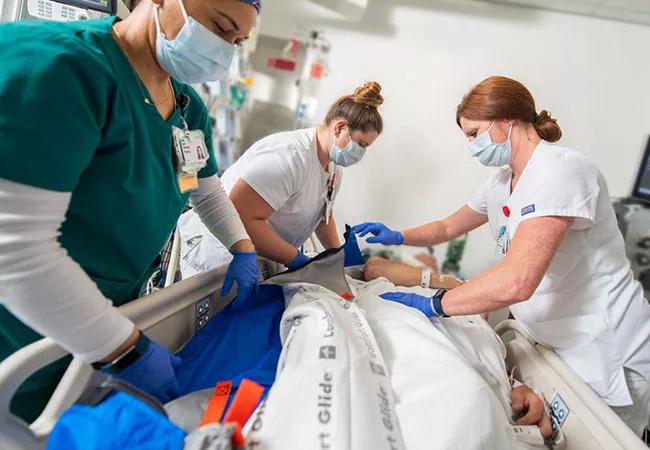Caregivers partner to prevent skin breakdown

The 24-bed coronary ICU on Cleveland Clinic’s main campus has high acuity patients who often require pressors and mechanical support, putting them at high risk for skin breakdown. In 2018, the unit reported 70 hospital acquired pressure ulcers (HAPUs). Clinical nurses on the unit decided to tackle the problem.
Advertisement
Cleveland Clinic is a non-profit academic medical center. Advertising on our site helps support our mission. We do not endorse non-Cleveland Clinic products or services. Policy
“HAPUs have such an impact on the patient’s length of stay, and they can lead to other issues and increase costs for the hospital,” says Amy Flowers-Surovi, BSN, RN, CCRN, a clinical nurse in the coronary ICU. “The benefits of decreased HAPU rates are so important, not only for the patient, but for the hospital system as well.”
A team of nurses including Flowers-Surovi and Mary Rimelspach, BSN, RN, began brainstorming solutions, informally interviewing nurses on the coronary ICU and discussing ideas at shared governance meetings. “It was a group effort with our nurse manager, assistant nurse manager, clinical nurses and clinical technicians on the unit,” says Rimelspach.
To help identify the root cause of HAPUs, the nurses created a fishbone diagram that outlined 15 factors falling into six main areas: environment, materials, patient, processes, equipment and caregivers. For instance, the diagram noted that a patient’s hemodynamic instability and size/weight contribute to HAPUs, as do malfunctioning beds and delays in getting supplies from the storeroom.
“One of the biggest issues cited by nurses was delays in turning patients because they couldn’t find someone to help,” says Flowers-Surovi. Clinical technicians (CTs) were often tied up with jobs such as patient care, stocking supplies and transport. To solve this primary issue, the coronary ICU implemented a turn team in January 2019.
The turn team comprises four clinical technicians who each round on six beds and help the nurses turn the patient, review supplies available in the room (such as boots and wedges) and order missing supplies. The CT utilizes a checklist to note the position of the patient (left, right, back) upon entry into the room, repositioning of the patient and examination of areas at high risk for skin breakdown.
Advertisement
During daily huddles, the nurses discuss the turn team’s activities, report on any HAPUs and provide education. For example, a representative from a healthcare equipment vendor re-educated nurses on using the Turn & Position System (TAP) to assist with repositioning critically ill patients. The nurse manager also reiterated the importance of turning patients on medical devices, such as extracorporeal membrane oxygenation (ECMO) machines, and inspecting their skin.
When the turn team was initiated on the coronary ICU, HAPUs decreased from 13 in December 2018 to two in January 2019. HAPUs decreased by 62.5% between the six months prior to the intervention and the first six months of 2019. The unit has maintained momentum in 2020. During the three months for which the coronary ICU has recorded data, there have been no HAPUs.
“The turn team has been very helpful. It has made a difference in caregiver engagement, creating a team atmosphere and achieving a common goal. One person can’t do this alone,” says Rimelspach. “It has helped raise awareness about HAPUs and therefore decreased the prevalence.”
Advertisement
Advertisement

Nurses harness cutting-edge technology as a bridge to healing

Project aims to improve patient care by streamlining caregiver transitions

Optimizing care while protecting patients from life-threatening reactions

Palliative nurses improve quality of life

Strong bonds and momentous milestones fuel life-changing work

Experts offer hands-on support and education

Special skills course aims to improve patient safety and comfort while building caregiver confidence

Bariatric nurses deliver sensitivity, compassion and skill